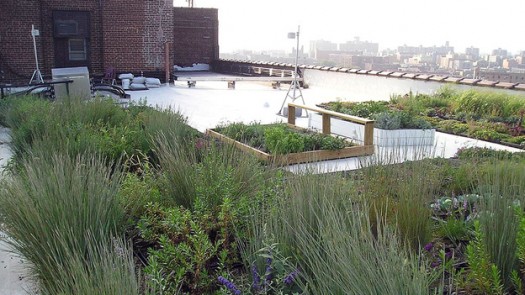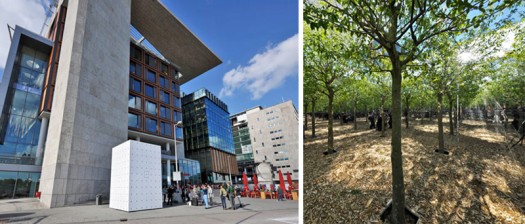
We are celebrating 15 years — and counting — of stories that are deeply researched and deeply felt, that build a historical record of what the city has been.
We are celebrating 15 years — and counting — of stories that are deeply researched and deeply felt, that build a historical record of what the city has been.

Image courtesy of Sustainable South Bronx via NPR
With temperatures in the triple digits earlier this week, residents in major cities like New York, Washington and Philadelphia felt the heat more so than those living in more rural areas due to the heat island effect. That said, a new study out of Georgia Tech posits that among cities, the wider the sprawl the greater the affects of climate change. In other words, get dense to get green! Back in January, the Omnibus brought you Clip-on Architecture: Vanessa Keith’s bold vision for how to knit green interventions into our existing urban building stock in order to redress the affects of tropical deforestation. Keith is hardly the only one turning attention to the roof in attempts to cool buildings, and thus the city, down. By creating the roofs out of a light-colored special polymer, or installing a rooftop garden, or “living roof,” you have the ability to reduce temperatures by almost half, as well as save on cooling costs. While the initial costs of installing such systems has often scared owners in the past, perhaps the weather of the past week will have them reconsider the option. One local enterprise, the Brooklyn Grange Farm, recently installed a green roof at their home in Long Island City, and also sell their goods at various markets around the city.
The design company IDEO is now using video and social media to promote positive thinking about climate change and its future impact on the Earth through their Living Climate Change project. They also recently announced the winner of their video challenge, which allowed filmmakers to showcase what their vision of the future shaped by climate change will be. Below is a short video explaining the premise behind it all (via Flavorwire):
Public transportation has long been touted as one way to lead a more sustainable life, but many New York City buses often move at the same speed as pedestrians, leading to frustration from passengers and city officials alike. However, thanks in part to an $18 million federal grant recently won by the city, plans for the 34th Street Transitway are one step closer to becoming a reality. With over 90% of the traffic at Herald Square coming from pedestrians or transit riders, the plan calls for buses to have their own corridors to allow them to function similarly to the subway, and hopefully be faster and more efficient. Hopefully this project will be the first of many successful ventures to revive the whole city bus system.

Images via WebEcoist; Left – exterior of the pavilion; Right – interior view of the “forest”
Green space may be at a premium in most major metropolitan areas, but DUS Architects out of Amsterdam created a small, wooded retreat for city dwellers with their Unlimited Urban Woods pavilion. From the outside it was just a small, unassuming box, but once you stepped inside they were able to create the illusion of a never-ending forest through the use of just one planted tree and carefully angled mirrors.
In recent years, New York City has been creating, expanding, and renovating numerous parks along the city’s waterfront, most recently the Brooklyn Bridge Park, which opened the first phase to the public in March of this year. However, one op-ed writer for the New York Times, offers the argument that while many are stating that we are “reclaiming” the waterfront, we’ve never really had control of it until now. When it was dominated by shipping and manufacturing in the 19th century and first half of the 20th, the waterfront was a dangerous, crime-ridden place, one that many New Yorkers did not dare to explore. According to the author, Nathan Ward, we’re not reclaiming it, we’re claiming it.
The New York City Economic Development Corporation has recently announced that it is seeking proposals to develop a new hub in the Bronxchester Urban Renewal Area in the Mott Haven neighborhood of the South Bronx. In addition to the new Yankees Stadium and plans for the Grand Concourse, the City is hoping to further encourage revival through the introduction of a mixed-use development including commercial space, community and educational centers, and other public and semi-public spaces.
Long Island was home to some of the first suburbs in the country, and back in March, the Long Island Index sponsored a competition to ‘Build a Better Burb’ and reconsider the notion in todays economic climate. The 23 finalists were recently announced, with many ideas centered around the concept of walkable, sustainable communities, and are now inviting the public to vote on the “People’s Choice” award. Winners will be announced in October 4th.
This weekend, July 9-11, the Anthology Film Archives is presenting “The Outer Boroughs on Film.” A majority of the documentaries being shown were filmed during the 1970’s and 80’s, when crime, disinvestment and a major fiscal crisis threatened the rapid decline of many neighborhoods in the Bronx, Queens, Brooklyn and Staten Island.
If you’ve ever been intrigued by what it takes to be a window cleaner, and what exactly they are thinking working high above the city streets, the New York Times recently had a two–part question and answer series with Andrew Horton. Horton was a window washer for over two decades and now runs the city’s main safety training program.
Robert Moses certainly left his mark on the city in the 1930’s, but one that has been unseen by most is the “Freedom” Tunnel, named after the graffiti artist Chris Pape, that runs under the Upper West Side. Used briefly by Amtrak, it then became home to many of the city’s homeless population, and a prime canvas for Pape and other graffiti artists. Functioning as an active train line once again, it offers urban explorers a world of stunning contrast to explore, as seen below (via Wooster Collective)
The Roundup keeps you up to date with topics we’ve featured and other things we think are worth knowing about.
The views expressed here are those of the authors only and do not reflect the position of The Architectural League of New York.